您好,登錄后才能下訂單哦!
您好,登錄后才能下訂單哦!
本篇內容主要講解“直接調用userMapper接口的方法是什么”,感興趣的朋友不妨來看看。本文介紹的方法操作簡單快捷,實用性強。下面就讓小編來帶大家學習“直接調用userMapper接口的方法是什么”吧!
老規矩,先上案例代碼,這樣大家可以更加熟悉是如何使用的,看過Mybatis系列的小伙伴,對這段代碼差不多都可以背下來了。
哈哈~,有點夸張嗎?不夸張的,就這行代碼。
public class MybatisApplication { public static final String URL = "jdbc:mysql://localhost:3306/mblog"; public static final String USER = "root"; public static final String PASSWORD = "123456"; public static void main(String[] args) { String resource = "mybatis-config.xml"; InputStream inputStream = null; SqlSession sqlSession = null; try { inputStream = Resources.getResourceAsStream(resource); SqlSessionFactory sqlSessionFactory = new SqlSessionFactoryBuilder().build(inputStream); sqlSession = sqlSessionFactory.openSession(); //今天主要這行代碼 UserMapper userMapper = sqlSession.getMapper(UserMapper.class); System.out.println(userMapper.selectById(1)); } catch (Exception e) { e.printStackTrace(); } finally { try { inputStream.close(); } catch (IOException e) { e.printStackTrace(); } sqlSession.close(); } }看源碼有什么用?
通過源碼的學習,我們可以收獲Mybatis的核心思想和框架設計,另外還可以收獲設計模式的應用。
前兩篇文章我們已經Mybatis配置文件解析到獲取SqlSession,下面我們來分析從SqlSession到userMapper:
UserMapper userMapper = sqlSession.getMapper(UserMapper.class);
前面那篇文章已經知道了這里的sqlSession使用的是默認實現類DefaultSqlSession。所以我們直接進入DefaultSqlSession的getMapper方法。
//DefaultSqlSession中 private final Configuration configuration; //type=UserMapper.class @Override public <T> T getMapper(Class<T> type) { return configuration.getMapper(type, this); }這里有三個問題:

問題1:getMapper返回的是個什么對象?
上面可以看出,getMapper方法調用的是Configuration中的getMapper方法。然后我們進入Configuration中
//Configuration中 protected final MapperRegistry mapperRegistry = new MapperRegistry(this); ////type=UserMapper.class public <T> T getMapper(Class<T> type, SqlSession sqlSession) { return mapperRegistry.getMapper(type, sqlSession); }這里也沒做什么,繼續調用MapperRegistry中的getMapper:
//MapperRegistry中 public class MapperRegistry { //主要是存放配置信息 private final Configuration config; //MapperProxyFactory 的映射 private final Map<Class<?>, MapperProxyFactory<?>> knownMappers = new HashMap<>(); //獲得 Mapper Proxy 對象 //type=UserMapper.class,session為當前會話 public <T> T getMapper(Class<T> type, SqlSession sqlSession) { //這里是get,那就有add或者put final MapperProxyFactory<T> mapperProxyFactory = (MapperProxyFactory<T>) knownMappers.get(type); if (mapperProxyFactory == null) { throw new BindingException("Type " + type + " is not known to the MapperRegistry."); } try { //創建實例 return mapperProxyFactory.newInstance(sqlSession); } catch (Exception e) { throw new BindingException("Error getting mapper instance. Cause: " + e, e); } } //解析配置文件的時候就會調用這個方法, //type=UserMapper.class public <T> void addMapper(Class<T> type) { // 判斷 type 必須是接口,也就是說 Mapper 接口。 if (type.isInterface()) { //已經添加過,則拋出 BindingException 異常 if (hasMapper(type)) { throw new BindingException("Type " + type + " is already known to the MapperRegistry."); } boolean loadCompleted = false; try { //添加到 knownMappers 中 knownMappers.put(type, new MapperProxyFactory<>(type)); //創建 MapperAnnotationBuilder 對象,解析 Mapper 的注解配置 MapperAnnotationBuilder parser = new MapperAnnotationBuilder(config, type); parser.parse(); //標記加載完成 loadCompleted = true; } finally { //若加載未完成,從 knownMappers 中移除 if (!loadCompleted) { knownMappers.remove(type); } } } } }MapperProxyFactory對象里保存了mapper接口的class對象,就是一個普通的類,沒有什么邏輯。
在MapperProxyFactory類中使用了兩種設計模式:
鴻蒙官方戰略合作共建——HarmonyOS技術社區
單例模式methodCache(注冊式單例模式)。
工廠模式getMapper()。
繼續看MapperProxyFactory中的newInstance方法。
public class MapperProxyFactory<T> { private final Class<T> mapperInterface; private final Map<Method, MapperMethod> methodCache = new ConcurrentHashMap<>(); public MapperProxyFactory(Class<T> mapperInterface) { this.mapperInterface = mapperInterface; } public T newInstance(SqlSession sqlSession) { //創建MapperProxy對象 final MapperProxy<T> mapperProxy = new MapperProxy<>(sqlSession, mapperInterface, methodCache); return newInstance(mapperProxy); } //最終以JDK動態代理創建對象并返回 protected T newInstance(MapperProxy<T> mapperProxy) { return (T) Proxy.newProxyInstance(mapperInterface.getClassLoader(), new Class[] { mapperInterface }, mapperProxy); } }從代碼中可以看出,依然是穩穩的基于 JDK Proxy 實現的,而 InvocationHandler 參數是 MapperProxy 對象。
//UserMapper 的類加載器 //接口是UserMapper //h是mapperProxy對象 public static Object newProxyInstance(ClassLoader loader, Class<?>[] interfaces, InvocationHandler h){ }問題2:為什么就可以調用他的方法?
上面調用newInstance方法時候創建了MapperProxy對象,并且是當做newProxyInstance的第三個參數,所以MapperProxy類肯定實現了InvocationHandler。
進入MapperProxy類中:
//果然實現了InvocationHandler接口 public class MapperProxy<T> implements InvocationHandler, Serializable { private static final long serialVersionUID = -6424540398559729838L; private final SqlSession sqlSession; private final Class<T> mapperInterface; private final Map<Method, MapperMethod> methodCache; public MapperProxy(SqlSession sqlSession, Class<T> mapperInterface, Map<Method, MapperMethod> methodCache) { this.sqlSession = sqlSession; this.mapperInterface = mapperInterface; this.methodCache = methodCache; } //調用userMapper.selectById()實質上是調用這個invoke方法 @Override public Object invoke(Object proxy, Method method, Object[] args) throws Throwable { try { //如果是Object的方法toString()、hashCode()等方法 if (Object.class.equals(method.getDeclaringClass())) { return method.invoke(this, args); } else if (method.isDefault()) { //JDK8以后的接口默認實現方法 return invokeDefaultMethod(proxy, method, args); } } catch (Throwable t) { throw ExceptionUtil.unwrapThrowable(t); } //創建MapperMethod對象 final MapperMethod mapperMethod = cachedMapperMethod(method); //下一篇再聊 return mapperMethod.execute(sqlSession, args); } }也就是說,getMapper方法返回的是一個JDK動態代理對象(類型是$Proxy+數字)。這個代理對象會繼承Proxy類,實現被代理的接口UserMpper,里面持有了一個MapperProxy類型的觸發管理類。
當我們調用UserMpper的方法時候,實質上調用的是MapperProxy的invoke方法。
userMapper=$Proxy6@2355。
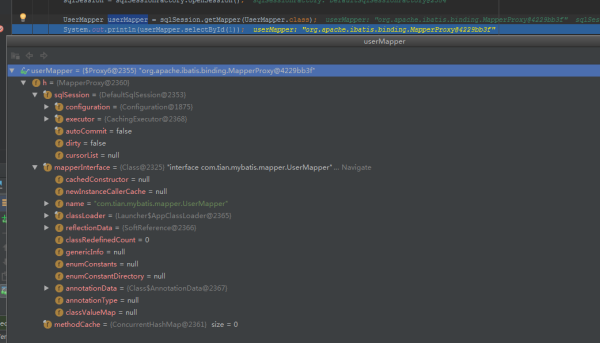
為什么要在MapperRegistry中保存一個工廠類?
原來他是用來創建并返回代理類的。這里是代理模式的一個非常經典的應用。
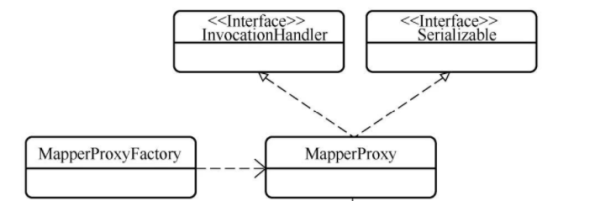
MapperProxy如何實現對接口的代理?
JDK動態代理
我們知道,JDK動態代理有三個核心角色:
被代理類(即就是實現類)
接口
實現了InvocationHanndler的觸發管理類,用來生成代理對象。
被代理類必須實現接口,因為要通過接口獲取方法,而且代理類也要實現這個接口。
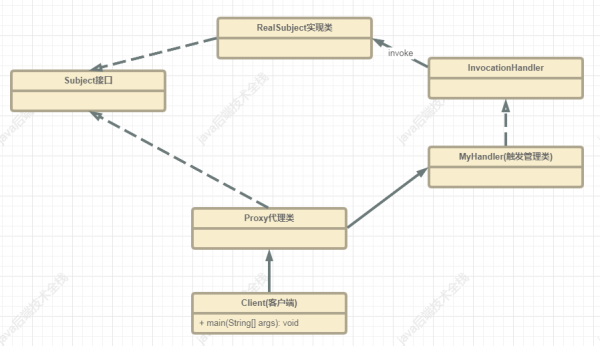
而Mybatis中并沒有Mapper接口的實現類,怎么被代理呢?它忽略了實現類,直接對Mapper接口進行代理。
MyBatis動態代理:
在Mybatis中,JDK動態代理為什么不需要實現類呢?
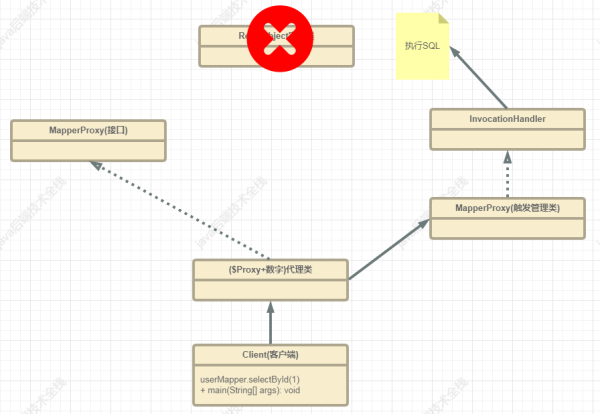
這里我們的目的其實就是根據一個可以執行的方法,直接找到Mapper.xml中statement ID ,方便調用。
最后返回的userMapper就是MapperProxyFactory的創建的代理對象,然后這個對象中包含了MapperProxy對象,
問題3:到底是怎么根據Mapper.java找到Mapper.xml的?
最后我們調用userMapper.selectUserById(),本質上調用的是MapperProxy的invoke()方法。
請看下面這張圖:
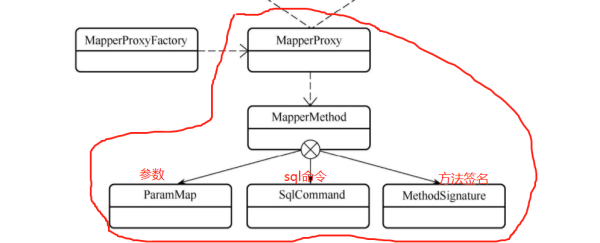
如果根據(接口+方法名找到Statement ID ),這個邏輯在InvocationHandler子類(MapperProxy類)中就可以完成了,其實也就沒有必要在用實現類了。
到此,相信大家對“直接調用userMapper接口的方法是什么”有了更深的了解,不妨來實際操作一番吧!這里是億速云網站,更多相關內容可以進入相關頻道進行查詢,關注我們,繼續學習!
免責聲明:本站發布的內容(圖片、視頻和文字)以原創、轉載和分享為主,文章觀點不代表本網站立場,如果涉及侵權請聯系站長郵箱:is@yisu.com進行舉報,并提供相關證據,一經查實,將立刻刪除涉嫌侵權內容。